
Espoo is a city in Finland. It is located to the west of the capital, Helsinki, in southern Uusimaa. The population is approximately 320,000. It is the 2nd most populous municipality in Finland. Espoo is part of the Helsinki Metropolitan Area, which has approximately 1.6 million inhabitants. Espoo is on the northern shore of the Gulf of Finland and borders Helsinki, Vantaa, Kirkkonummi, Vihti and Nurmijärvi. The city includes the enclave of Kauniainen. Espoo covers an area of 528 square kilometres (204 sq mi). Espoo is a bilingual municipality with Finnish and Swedish as its official languages. The population consists of 70% Finnish speakers, 6% Swedish speakers, and 24% speakers of other languages, well above the national average.

Haukilahti is a neighbourhood in Espoo, Finland. It is located on the seashore of the Gulf of Finland in the southern part of the city.

St. John's Church in Helsinki, Finland, is a Lutheran church designed by the Swedish architect Adolf Melander in the Gothic Revival style. It is the largest stone church in Finland by seating capacity.

Temppeliaukio Church is a Lutheran church in the Töölö neighbourhood of Helsinki, Finland. The church was designed by architects and brothers Timo and Tuomo Suomalainen and opened in 1969. Built directly into solid rock, it is also known as the Church of the Rock and Rock Church.

Espoonlahti (Finnish) or Esboviken (Swedish) is one of the five major urban areas of Espoo, a city in Finland. It lies along the south-western coast of Espoo, bounded to the west by the bay of the same name, to the south by the shores of the Gulf of Finland, to the west by the Finnoo (Finnå) valley, to the east of the municipal border of Kirkkonummi, and to the north by the forests of Espoo central forest area. This total area of about 4,800 hectares is further divided into areas called Soukka, Suvisaaristo, Kaitaa, Nöykkiö, Latokaski and Saunalahti, with one greater center called Espoonlahden keskus. Areas known as Laurinlahti, Ylä-Kivenlahti, Ala-Kivenlahti and Iivisniemi are also part of the Espoonlahti district. Yet another name pertinent to this area is Kanta-Espoonlahti, which includes Espoonlahden keskus, Soukanmäki, Kivenlahti, Laurinlahti and Soukanniemi.

Jakobstad Church is a Lutheran church in the city of Jakobstad, Finland. It was constructed in 1731 by Johan Knubb. The church has been built on the same place, where the first church in Jakobstad was located before it was burned down by Russians in 1714.
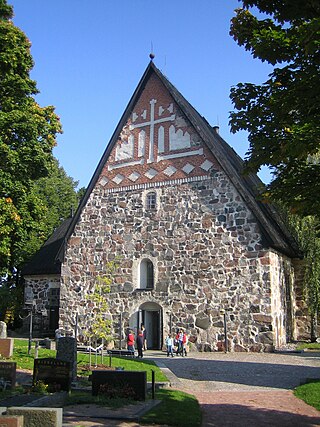
Espoo Cathedral is a medieval parish church and cathedral in Espoo, Finland. It is the seat of the Evangelical Lutheran Diocese of Espoo, established in 2004. The cathedral is located in the district of Espoon keskus, near the Espoonjoki river. The oldest parts of the church were completed in the 1480s and it is thus the oldest preserved building in the city.

The Finlayson Church is a church built in Gothic Revival style located in the Finlayson industrial area in the district by the same name in Tampere, Finland. It was built in 1879 as the church of the Finlayson cotton factory, where the factory workers could practice religion. Currently the church belongs to the Evangelical-Lutheran congregations of Tampere, and it is used as a children's road church and a popular church for weddings.

Myyrmäki Church, is a Lutheran church in the Myyrmäki neighborhood in the city of Vantaa. It is located near Louhela commuter train station. The church was designed by architect Juha Leiviskä and it was opened in 1984. It is also known as the Church of Light. In Leiviskä's own words: "To me, a building as such, 'as a piece of architecture', is nothing. Its real significance is revealed in counterpoint with its surroundings, with life and with light."
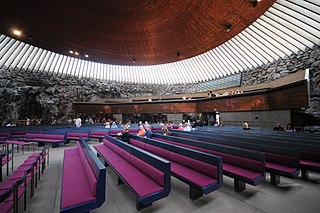
Tuomo Oskari Suomalainen was a Finnish architect born in Gogland. He worked very closely with his brother Timo Suomalainen who also was an architect. Most of the works they designed jointly.
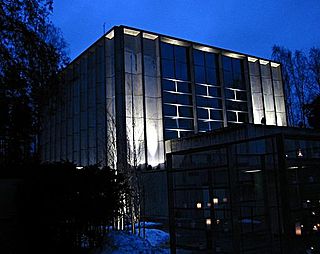
Tapiola Church is a Lutheran church in the Tapiola district of Espoo, Finland. The modernist concrete building in brutalist style was designed by the architect Aarno Ruusuvuori and opened in 1965. The church seats 600 people and is thus the largest in Espoo by capacity.

St. Mary Catholic Parish is a Roman Catholic parish based in the Meilahti neighborhood of Helsinki, Finland. Pastoral care is entrusted to the Priests of the Sacred Heart.

The Church of St. Lawrence is a church in Vantaa, Finland. Dating back to ca. 1450, it is the oldest building in Vantaa and all of Greater Helsinki. It is also the main church of the Tikkurila Parish. Along with its surrounding neighborhood, the church is a part of the Helsingin pitäjän kirkonkylä district, which is one of the best preserved historical parishes in all of Finland.
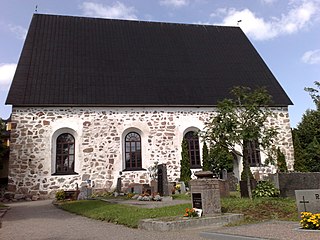
Siuntio St. Peter's Church is a gothic medieval stone church in Siuntio, Uusimaa, Finland, located in the old church village of Siuntio. The church is built out of grey stone between the years 1460 and 1480 next to a small stone chapel which was owned by a nearby Suitia Manor. St. Peter's Church is divided into three naves by three pairs of pilars that hold the brick vaults.

The Alexander Church is a stone church in Tampere, Finland, and it is part of the Tampere Cathedral Parish. It is located in the Kaakinmaa district in the city center of Tampere, on the edge of the Hämeenpuisto park along the Pirkankatu street. The church, designed by architect Theodor Decker, was built of brick between 1880 and 1881. It is named after Emperor Alexander II of Russia. The church is surrounded by Pyynikki Church Park, a former cemetery.
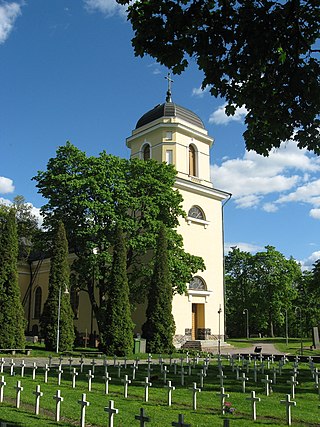
Vihti Church is a Lutheran church built in 1772 in Vihti, Finland. The church is located in Vihti church village on Hartanmäki Hill. Vihti church was constructed according to Antti Piimänen's plans. The church has been ravaged by fire twice and both times it was reconstructed. Vihti church is also sometimes referred to as Gustav's Church after Gustav III of Sweden.
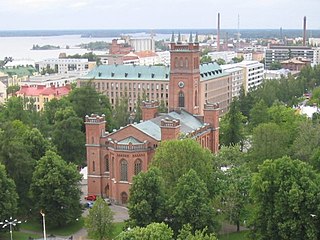
The Vaasa Holy Trinity Church, or simply the Vaasa Church, is a church located in the city center of Vaasa in Ostrobothnia, Finland. The 900-seat red-brick church, designed by architect Carl Axel Setterberg, was completed in 1869.

St. Michael's Church in Kirkkonummi is a gothic, medieval stone church in the Finnish municipality of Kirkkonummi, located in the municipal town centre. The church was built somewhere between 1400 and 1490. The original medieval brick walls are still to be seen in the eastern part of the church.

Anttola is a village and a former municipality of Finland located in the modern region of Southern Savonia. Together with Mikkelin maalaiskunta, it was consolidated with the town of Mikkeli in 2001.

Nummi Church is a Lutheran stone church in the former municipality of Nummi, situated in the Finnish city of Lohja in the Uusimaa region. Constructed of gray stone in 1822, the church was designed by Abraham Niklas Edelcrantz at the Royal Intendent's Office in Stockholm in 1807.





















